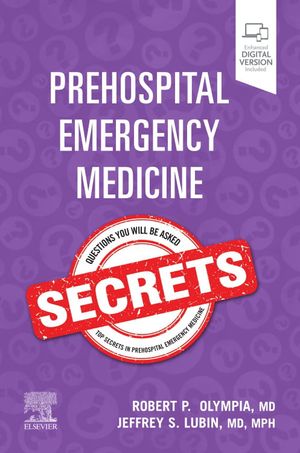- 56,99$
- Membre: 5589$
Contents
[draft of TOC – upon approval, I would seek additional reviews by experts on contents before finalizing, including Dr. Peter Cameron]
Top 100 Secrets
Section 1 History of Emergency Medical Services
- History of Emergency Medical Services
- Destination Guidelines and Hospital Designation
- Emergency Vehicle Operation
- EMS System Design
- Media and Public Relations
- Medical Direction
- Medicolegal Issues
- Prehospital Communications
- Public Health and EMS
- Quality Improvement
- Research in EMS
- Critical Incident Stress
- Infectious Disease Exposure
- Occupational Health Issues in EMS
- Scene Safety
- Decision making and critical interpretation of vital signs
- Prehospital physical assessment
- Abdominal pain, vomiting and diarrhea, dehydration
- Altered mental status
- Arrhythmias
- Cardiac arrest, including ECMO
- Cardiac emergencies – chest pain, STEMI, ACS, CHF
- Cardiac device emergencies – pacemaker/implanted defibrillator dysfunction, left ventricular assist devices
- Diabetic emergencies
- Gastrointestinal hemorrhage
- Hypotension and shock
- Infectious disease emergencies/sepsis
- Psychiatric emergencies/Care of the agitated or suicidal patient
- Obstetrics and Gynecologic emergencies
- Overdose
- Poisonings
- Renal failure and dialysis
- Respiratory emergencies – anaphylaxis, COPD, asthma, pneumonia
- Seizures
- Stroke and TIA
- Syncope
- General Adult trauma principles and triage
- Head injuries and facial trauma
- Cervical spine and spinal cord injuries
- Chest, abdominal, and pelvic injuries
- Extremity injuries
- Penetrating injuries
- Thermal burns and inhalational injuries
- Care of the entrapped patient, including crush injury
- Decision making and critical interpretation of vital signs
- Abdominal pain, vomiting and diarrhea, dehydration
- Altered mental status
- Cardiac arrest and arrhythmias
- Chest pain and syncope
- Infectious disease emergencies/sepsis
- Prehospital physical assessment
- Respiratory distress emergencies – asthma, bronchiolitis, croup, pneumonia, anaphylaxis
- Seizures
- Shock
- Technology dependent children
- Poisonings
- General Pediatric trauma principles and triage
- Head injuries and facial trauma
- Cervical spine and spinal cord injuries
- Chest, abdominal, and pelvic injuries
- Extremity injuries
- Penetrating injuries
- Thermal burns and inhalational injuries
- General principles in disasters and multiple casualty incidents
- Prehospital triage for mass casualties
- Mass casualty evacuation and patient movement
- Biological terrorism
- Chemical terrorism
- Radiation and radiation injury
- Blast injuries
- Hazardous materials response
- Tactical EMS
- Search and rescue
- Community disaster preparedness
- General principles in wilderness medicine
- Bites, stings, and envenomations
- Decompression illnesses
- Dysbarisms
- Heat related illness
- Hypothermia
- Lightning and electrical emergencies
- Submersion injuries/drownings
- Wilderness survival
- Interfacility transport, including Ground Critical Care Transport
- Bariatric emergencies
- Geriatric emergencies
- Aeromedical Transport
- Community Paramedicine
- Intimate partner violence, sexual assault, and child maltreatment
- End of life issues
- Airway Management
- Analgesia and sedation
- CPR, AED, mechanical compression
- Electrocardiogram interpretation
- Field amputation
- Hemorrhage control
- Intravascular/ interosseous access and fluids resuscitation
- Oxygenation and ventilation
- Perimortem caesarian section
- Point of care testing
- Procedures in the trauma patient
- Splinting and spinal immobilization
- Telemedicine and emerging telecommunications
- Termination of resuscitation
- Transport of the highly infectious patient
Section 2 Emergency Medical Services Operations
Section 3 Personal Safety and Wellness
Section 4 Adult Medical Care
Section 5 Adult Trauma Care
Section 6 Pediatric Medical Care
Section 7 Pediatric Trauma Care
Section 8 Disaster and Multiple Casualty Incidents
Section 9 Wilderness EMS and Austere medicine
Section 10 Special Prehospital Situations
Section 11 Prehospital Skills and Procedures
Catégories
Caractéristiques
-
- ISBN9780323722667
- Code produit260695
- ÉditeurELSEVIER (CANADA)
- Date de publication26 janvier 2023
- FormatPapier
Disponible dans les succursales suivantes
L’inventaire et le prix sont sujets à changement. Nous vous suggérons de contacter Coop Zone avant de vous déplacer:
- 0
Centre-Ville
0
